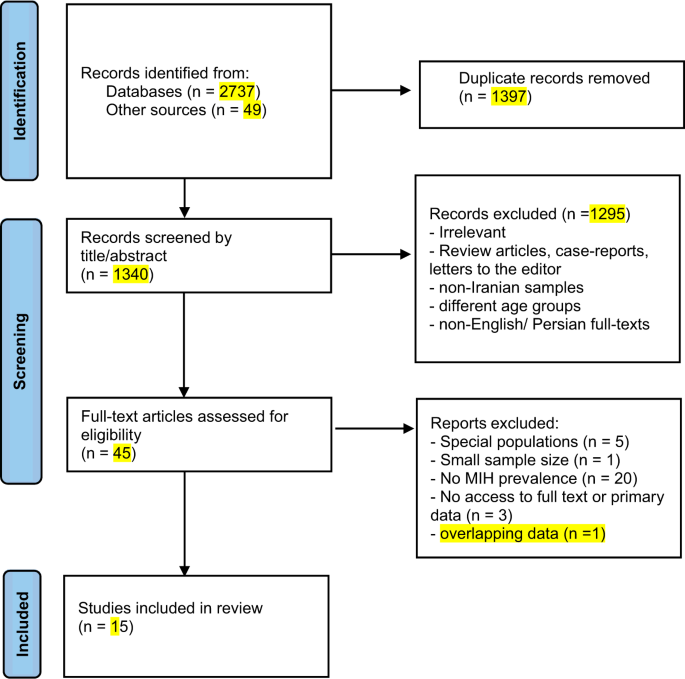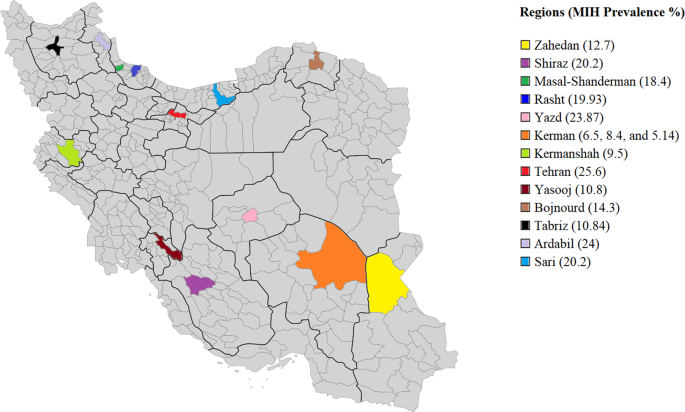Literature search and
The flow chart for study selection is presented in Fig. 1. The initial search resulted in 2737 titles from databases and 49 from other sources. Of 45 articles reviewed in full-text, most were excluded because they did not report the prevalence rates. Five articles were excluded because they focused on special populations. One study was excluded because of overlapping data [16].

The PRISMA flow diagram for the systematic review detailing the study screening and selection process including number of studies screened, number of excluded and retrieved studies, and the reasons for exclusion.
Providing the prevalence rate of MIH could be extracted, studies with a primary outcome rather than prevalence of MIH in random population were also included. Only one study was excluded because of small sample size [17]. Fifteen studies met the final inclusion criteria for the review [18,19,20,21,22,23,24,25,26,27,28,29,30,31,32].
Characteristics of included studies
Description of the included studies is shown in Table 1. The total sample size in 15 included studies (9 published and 6 unpublished) was 12011 participants. The included studies originated from 13 geographic areas. All of the included studies were performed in school-based settings. Published studies were published between 2012 and 2021; and unpublished studies which all were dissertations or theses, were conducted between 2015 and 2019.
Of the 15 included studies, 9 were written in Persian and 6 were written in English. All included studies were cross-sectional. Among the eligible studies, two used DDE diagnostic criteria, one used a combination of EAPD and mDDE and the rest used EAPD diagnostic criteria. The sample size of included studies ranged from 369 to 2507.
Quality assessment of included studies
The included studies were evaluated using a modified version of the NOS adapted for cross-sectional studies. The scale produces a score between 0 and 8. Study was considered as high quality when NOS was 7–8, moderate quality when NOS was 4–6, and low quality when NOS was 3 and less. All of the included studies were scored as moderate quality (NOS of 4–6).
Prevalence by geographical region
There was substantial variation in reported MIH prevalence rates. Of the 13 studied geographical regions, the lowest prevalence of MIH was detected in Kerman [31] (5.14%) and the highest in Tehran [25] (%25.6). Kerman was the most studied region with prevalence rates of 6.5%, 8.4%, and 5.14% in three studies [23, 26, 31] Fig. 2.

Map highlighting the regional distribution of prevalence of MIH in Iran based on the records retrieved in the systematic review.
Prevalence by sex
Twelve studies compared prevalence rates in two genders [18,19,20,21, 23,24,25, 27,28,29,30, 32]. Two study reported that MIH lesions were seen more often in girls [19, 24] while others reported no significant difference of prevalence between two genders. One study focused only on girls [26], while others included both genders.
Prevalence by tooth type and dental arch
Of the 15 included studies, 10 assessed the prevalence of MIH according tooth type [18, 19, 21, 23,24,25, 27, 28, 31, 32]. One study reported the upper right molars and central incisors as the most frequently affected teeth [19], while others reported that molars were more affected than incisors. Two studies reported no significant difference in the MIH prevalence in lower and upper arches [19, 28]. One study reported that prevalence of MIH was higher in the lower arch [23], while 2 other studies study reported the lesions to be more prevalent in the upper arch [24, 27]. one of the included studies reported that lower molars were more affected than upper molars, while upper incisors were more affected than lower ones [21]. Finally, one study declared that no significant difference was revealed in the prevalence of affected molars by dental arch, while incisors were more affected in the upper arch [21].
Prevalence by age
Eight of the included studies reported MIH prevalence according to age [19,20,21, 24, 25, 28, 29, 31], most of which showed no specific trend [19, 20, 25, 28, 29]. Two studies showed a higher prevalence with increasing age [21, 24]. Also MIH prevalence according to age groups was reported in one study but not analyzed statistically, though lack of specific trend with increasing age was observed from presented data [31].
Other notable findings
Dental caries
As logically anticipated, DMFT was reported to be significantly higher in children affected with MIH than the control groups in most studies [18, 22, 26, 28]. Also one study, though not using DMFT index, declared that more children had dental caries in MIH group than the control group 29. However, surprisingly one study showed a reverse relationship between prevalence of MIH and DMFT [24].
Etiologic factors
Of the studies reviewed, nine assessed the etiological factors of MIH. According to the obtained data, history of the following factors had statistically significant impact on MIH prevalence:
Prenatal and perinatal: Pregnancy complications [18], persistent fever during pregnancy [26], type of delivery [18, 25, 27, 28], birth complications [18, 25], hypoxia during delivery [26], premature birth [18, 29], medicine use during pregnancy [29], smoking during pregnancy [29], Use of amoxicillin during pregnancy [29], and maternal diabetes mellitus [27].
Postnatal: Ear infection [18], chicken pox [18, 25, 29], renal failure [18], allergies [18], amoxicillin usage [18, 25], Birth delivery type [25, 27, 28], breastfeeding over 12 months [18, 20, 27, 29], urinary tract infection [25, 29], high fever [26, 30], jaundice and exchange transfusion 29, breast-milk allergy [29], asthma and other respiratory diseases [29, 30], allergy [30], cleft lift and palate [29], vitamin deficiency [29], history of diarrhea and vomiting [29], history of hospitalization [30]. One of the reviewed studies did not find a significant association between any of the prenatal, perinatal, and postnatal factors on the MIH prevalence [21]
body mass index (BMI) and body weight
Four studies assessed the association of MIH and BMI or body weight [19, 22, 26, 28]. One of these studies showed a negative relationship between obesity and MIH [19], one study showed no relationship between BMI and MIH prevalence [22]. Another study declared that MIH prevalence was higher in low weight children [26]. And finally, one study showed no statistically significant relationship between MIH prevalence and BMI in general population of children or in girls, while the condition was more prevalent in boys with normal BMI [28].

